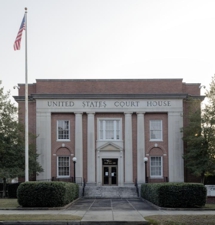Region 4's commitment to historic preservation
In addition to maintaining our historic building inventory throughout Region 4, our historic preservation team here at GSA also ensures that new construction, preservation projects, and routine maintenance all meet the nation’s historic preservation goals outlined in the National Historic Preservation Act of 1966 (NHPA). The general provisions of NHPA stipulate that it is the policy of the Federal Government, in partnership with States, local governments, Indian tribes, Native Hawaiian organizations, and private organizations to foster conditions in which historic properties can be leveraged to provide benefits to the public. This means that GSA, along with other Federal agencies, play a role in ensuring that the nation’s cultural resources are available to the public for education, outreach, and other social and economic benefits. The following projects are examples of how GSA’s Historic Preservation team helps provide public benefit in addition to meeting our responsibilities of the National Historic Preservation Act.

The Montgomery Greyhound Bus Station in Montgomery, Alabama now functions as the Freedom Rides Museum following a partnership between GSA, The Alabama Historical Commission (AHC), the U.S. District Court for the Middle District of Alabama and members of the Greyhound Bus Station Advisory Committee. Following a plan to expand the Frank M. Johnson, Jr. Federal Building and U.S. Courthouse, GSA agreed to convey the property to the AHC to interpret its significance as a major location involved in the Civil Rights Movement. Now serving the community as the Freedom Rides Museum, this site educates visitors about the 1961 Freedom Riders while also providing many other benefits associated with heritage tourism.

Ahead of the construction of the new U.S. Courthouse in Anniston, Alabama, GSA worked with the State Historic Preservation Office and the City of Anniston to consider the impacts of new construction on the Downtown Anniston Historic District. To minimize the effect of the project on the surrounding historic properties, GSA chose to meet their responsibilities under Section 106 of NHPA by interpreting the history of the block on a public facing website. Anniston Federal Courthouse: A Fresh Take on the Model City is a storymap interpreting the history of the surrounding area dating back to the founding of Anniston. These stories, scanned documents, and photographs span the block’s history from its use as a residential block through the construction of the new courthouse. Interpretive projects such as these are an important component of meeting our requirements under NHPA by providing interpretive information to local communities and the public.

More recently, GSA transferred ownership of the Charles E. Simons Jr. Federal Courthouse to Aiken County in South Carolina under the Historic Surplus Property Program administered by the National Park Service. Through this program, historic properties that were constructed for Federal use can be adapted and reused by state or local governments for uses such as offices, community centers, commercial facilities, or housing. Requirements of the program ensure that after a historic property leaves GSA ownership, new uses, upgrades, or additions must meet the Secretary of the Interior Standards for the Treatment of Historic Properties.
These projects, alongside many others, highlight GSA’s commitment to the preservation, interpretation, and continued use of historic properties and resources that have been under our ownership or impacted by new construction.
In celebration of National Preservation Month throughout May, please direct any questions regarding our historic portfolio and maintenance to our Regional team:
Danita Brown, Regional Historic Preservation & Fine Arts Officer
Ivy Freitag, Historic Preservation & Fine Arts Specialist
Sarah Love, Historic Preservation & Fine Arts Specialist

 U.S. General Services Administration
U.S. General Services Administration